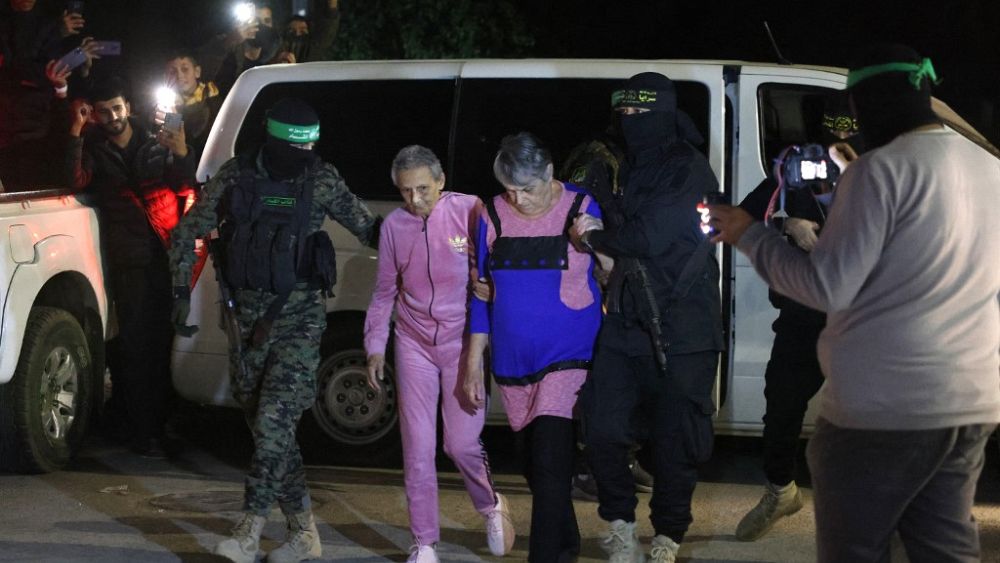A new group of hostages held in Gaza was released on Tuesday in exchange for the release of 30 Palestinians imprisoned by Israel, after the truce between Palestinian Hamas and the Israeli army was extended for 48 hours.
Several women accompanied by masked Palestinian fighters from Hamas and Islamic Jihad, another Palestinian armed group, were handed over to the International Committee of the Red Cross (ICRC) in Rafah, in the south of the Palestinian territory near the Egyptian border, according to an AFP photographer on site. They then boarded ICRC vehicles.
According to the Israeli army, citing “information received from the Red Cross”,“12 hostages, ten Israelis and two foreigners, are on their way to Israel.”
The extension of the truce, until 05:00 GMT on Thursday, should allow the release on Tuesday and Wednesday of 20 Israeli hostages and 60 Palestinian prisoners, according to Qatar, the main mediator in the negotiations on the hostage issue.
A source close to Hamas had earlier indicated that 10 Israeli hostages and 30 Palestinian prisoners were to be released on Tuesday, as well as “several foreign workers” not affected by the truce agreement.
Every day since the truce came into force on Friday, Hamas has released around ten women and children kidnapped during its bloody attack on October 7 in Israel, in exchange for the release of three times as many Palestinian prisoners.
This truce agreement negotiated under the aegis of Qatar, with the support of Egypt and the United States, has so far enabled the release of 60 Israeli hostages and 180 Palestinians imprisoned in Israeli prisons.
Twenty-one foreign hostages, the majority Thais living in Israel, were released outside the framework of this agreement.
The army estimated that around 240 people were kidnapped and taken to Gaza on October 7, during the unprecedented Hamas attack that claimed the lives of 1,200 people in Israel, the vast majority civilians, according to authorities.
In retaliation, Israel promised to “annihilate” Hamas, which carried out its attack from the Gaza Strip, relentlessly bombing the Palestinian territory and launching a ground offensive on October 27.
According to the Hamas government, 14,854 people, including 6,150 under the age of 18, were killed in Israeli strikes.
“Release all hostages”
On the fifth day of the truce, Israeli Prime Minister Benjamin Netanyahu remains under very strong pressure from public opinion, traumatized by the attack by Hamas, classified as a terrorist organization by the United States, the European Union and Israel.
“We will release all the hostages,” he said on Tuesday. “We will destroy this terrorist organization (Hamas, Editor’s note) and ensure that Gaza is no longer a threat to the State of Israel.” he repeated.
“The Israeli army is ready to resume fighting. We are taking advantage of the days of pause to (…) strengthen our preparation and approve future operation plans,” said Israeli Chief of Staff, General Herzi Halevi.
Tuesday in Tel Aviv, demonstrators brandished his portrait demanding the release of a 10-month-old infant, Kfir, captured in Kibbutz Nir Oz on October 7 with his brother Ariel (4 years old) and his parents Yarden and Shiri .
The oldest hostage to have been kidnapped on the same day, Yaffa Adar, 85, left on Tuesday, with her walker and under a guard of honor, the Israeli hospital where she had been transferred after her release from captivity on the 24 november.
Shortly before the truce was renewed, Mr. Netanyahu’s office agreed to include “50 prisoners” including Ahed Tamimi, young icon of the Palestinian cause arrested in early November, on the list of Palestinians likely to be released.
Continuation of mediations
Behind the scenes, mediators are working to extend the truce beyond Thursday and American Secretary of State Antony Blinken is expected back in Israel and the West Bank this week.
The heads of the American and Israeli intelligence services are in Doha.
Despite the pause in fighting, the situation remains precarious in Gaza, where the Israeli army said three explosive devices exploded near its forces in the northern Gaza Strip and that “terrorists” opened fire against his soldiers who retaliated.
The extension of the truce also allowed the entry of new humanitarian aid trucks into the Gaza Strip, besieged and bombarded for seven weeks by the Israeli army.
Despite the arrival since November 24 of hundreds of trucks in the small territory where 1.7 of the 2.4 million inhabitants have been displaced by the war, the situation remains “catastrophic”, judged the World Food Program (WFP), estimating that“there is a risk of famine” in Gaza.
Already subject to an Israeli land, sea and air blockade since 2007, the overpopulated territory was placed under total siege by Israel on October 9, and has since suffered serious shortages of water, food, fuel, medicine and of electricity.
The World Health Organization (WHO) has cited a “massive increase” of certain contagious diseases.
“Twenty-seven years to build it and it’s all gone!”
More than half of homes have been damaged or destroyed in the Gaza Strip, according to the UN.
Thousands of Palestinians, displaced in the south of the Gaza Strip, took advantage of the truce to return to their homes in the north, the most devastated region, ignoring the ban by the Israeli army which took control of several sectors.
“I’m trying to find memories of my home”, says a Palestinian from al-Zahra, pointing to the mountains of rubble where his house was located, destroyed by Israeli strikes.
“Al-Zahra was the most beautiful city in the world (…) and now it has disappeared,” said Zein Ashour, a young woman who also lived in this now razed neighborhood.
Taghrid al-Najjar, a 46-year-old mother, found refuge with her family in a school in the southern Gaza Strip, before returning home to the village of Abassane, in the same area, and discovering his house destroyed.
“Twenty-seven years to build it and it’s all gone!”



